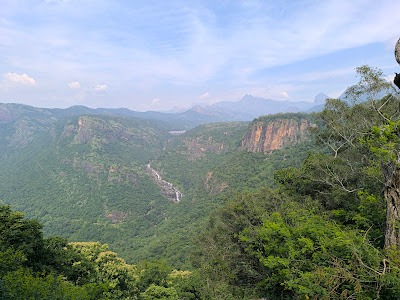
Image source: Bhuvanesh
About Hornbill viewpoint
One of the most captivating spots in Valparai, Hornbill viewpoint is a hotspot location for nature lovers and photographers. It’s a must-visit destination that offers breathtaking views of the lush green hills and valleys of the Western Ghats.
Anyone who is approaching on the scenic Pollachi-Valparai Road should reach this spot by passing through hairpin bends surrounded by tea plantations, dense forests, and mist-laden landscapes.
At a short distance from the viewpoint, Upper Aliyar Dam adds to the beauty of the area. Visitors can enjoy panoramic views of the reservoir and the surrounding hills, making it a perfect spot for photography and picnics.
Nature’s Performers: The Breeding Rituals
When breeding season approaches, the forest of Valparai witnesses a spectacular natural drama. A special phenomenon called casque-butting happens where male Great Hornbills engage and clash their beaks with loud echoes to impress a prospective mate.
Once a pair is formed, an intimate ritual of courtship begins. The female hornbill chooses a natural tree cavity, often in towering trees, and seals herself inside using a cement-like mixture of mud and droppings, leaving just a narrow slit open. The male feeds the female and her chicks through this gap and displays an extraordinary example of trust and cooperation in the wild.
Survivors in a Changing Landscape
While Great Hornbills are associated with dense rainforests, the birds of Valparai have shown remarkable adaptability. Due to the increase in coffee plantations, many trees are cut in the region, so these birds have found nesting in the tall trees. To support the right ecological support in human-modified landscapes, many such shade-grown coffee plantations are necessary.
But despite all this, the unique behaviors of birds show resilience and also the importance of sustainable farming and conservation practices that integrate biodiversity into working landscapes.
Seed Dispersers of the Forest
Hornbills played a crucial role in maintaining the health of the ecosystem. They are often called the “farmers of the forest” because while consuming a wide variety of fruits, seeds are spread over long distances. It helps in the regeneration of the forest and creates a ripple effect that provides a delicate balance of the tropical ecosystem.
Conservation at a Crossroads
Despite their impressive adaptability, hornbills are facing the threat of habitat loss and human disturbance. During uncontrolled tourism, many people come to watch nesting sites, which can have unintended consequences. It discourages males from feeding their secluded partner, which risks the survival of the chicks. Conservationists emphasise the need for silence, distance, and respect during the hornbill breeding season.
Although several efforts are underway in Valparai to create awareness among tourists and locals. But other initiatives, like protecting key nesting trees and working alongside plantation owners to preserve essential habitats, are also necessary steps.
Otherwise, protecting these magnificent birds isn’t just about saving a species—it’s about preserving the soul of the rainforest itself.
Wildlife at Attakatti Checkpost
Attakatti Checkpost falls below 500 m before the Hornbill viewpoint. The checkpoint also serves as an entry point to the lush forests of Valparai.
Tips for Visitors
Best Time to Visit: The ideal time to visit is between October and March, when the weather is cool and the region is lush after the monsoon season.
How To Reach Hornbill viewpoint
At a distance of 10 km from Monkey Falls and 28 km from Valparai.
